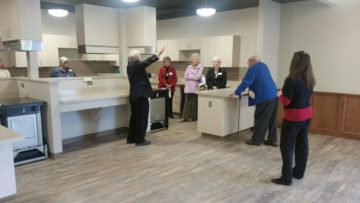By JAN LARSON McLAUGHLIN
BG Independent News
The tour of the new Cocoon shelter was personal for some of those getting their first look Sunday at the safe place for survivors of domestic and sexual violence.
As a counselor, Joan Staib worked with a girl who saw her mom stabbed to death by her father.
“I could tell you 60 stories of women impacted by domestic violence,” Staib said as she toured the new Cocoon.
Places like this, she said, can help prevent the violence or help survivors deal with the aftermath. “The healing can be awesome,” she said.
The tour was also personal for Becca Ferguson. Her mother was the victim of domestic violence, at a time when there were few services to help.
“Her attorney told her to get in a car and drive to Florida,” from her home in Georgia, Ferguson said.
“Violence toward women is a problem everywhere, including Bowling Green and Wood County,” Ferguson said as she stood in the kitchen of the new Cocoon. “I firmly believe we need safe places everywhere, especially for women and children.”
The new Cocoon site will include living spaces for those in emergency situations. The shelter portion is scheduled to be open later this month.
The building will also have advocacy services for victims of violence who need help navigating the court system, learning financial management skills, and other services. The new site, under director Michelle Clossick, allows all the services and sheltering to be in one location.
The shelter portion of the site will be able to house twice as many people as the current Cocoon shelter which opened 12 years ago in an apartment building in Bowling Green. The new site will have improved security, with several cameras, fencing, and entrance by key cards.

Large community kitchen area at the new Cocoon site
Unlike the current shelter, the new more spacious site has a large kitchen with a community dining area, a playroom for children, pet-friendly rooms, and handicapped accessible rooms. Plans call for outdoor play areas, a garden, and walking path to create nurturing spaces and reduce the impact of trauma.
“It gives us the ability to provide a sense of community,” as well as security and safe places for children to play, said Kathy Mull, program director.
“Some people who may be reluctant to come to our current facility may be more comfortable coming here,” said Cocoon board member Paul Haas.
“Safety is a huge issue,” Haas said as he led a tour on Sunday. “There are cameras all over this facility.”
The shelter section has 24 beds, compared to the current site’s 12 beds which are often at capacity.
“We do turn folks away from time to time,” said Courtney Schaefer, director of finance for the Cocoon.
The goal is to provide transitional housing to survivors of sexual and domestic violence and sex trafficking.
“This is an emergency shelter,” with the goal of 90-day maximum stays, Haas said. “The intent is to help people move back into society in a safe place.”
Sheltering makes up just 10 percent of the services provided by the Cocoon. The remaining 90 percent includes counseling, legal help getting restraining orders, programming to help with employment, safety assistance, and financial advice. The Cocoon staffs a crisis hotline round-the-clock, and is on-call to go to the hospital to help victims of sexual assaults.
“We’re not just a place where people come. We work on advocacy all the time,” Haas said.
The estimate is that the Cocoon will advocate for about 600 people this year, and shelter about 60.
The vast majority of those living at the shelter are people from Wood County, unless someone from outside the county needs to leave their home county for safety reasons, Mull said.

The new Cocoon site
The new Cocoon site is a $3.5 million project. The shelter side is nearly complete, and the offices will come next. The program has secured some grant funding, but that is always uncertain from year to year.
“We’ve had great community support,” Mull said. “We couldn’t do it without the help of the community.”
Donations help with everyday needs of those staying at the shelter. “Some folks come with nothing,” Haas said.
Many people in the community have pitched in to help.
“To have the community support that this has is really amazing,” Schaefer said.
But to complete the building renovations, furnish the rooms, and keep the program operating, the board needs more than $10 donations, Haas explained.
The community has been generous, but “the donor base is not full of people with deep pockets,” he said.
Efforts are being made to start a capital campaign that will help with the sustainability of the site. “We need to work on that,” Haas said.





